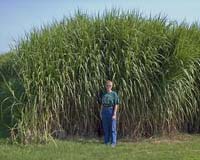 |
Columbia MO (SPX) Jan 17, 2011 U.S. agricultural practices create 58 percent of nitrous oxide in the world, which is the third most prevalent greenhouse gas in the atmosphere. Scientists believe nitrous oxide contributes to global warming about 300 times more than carbon dioxide. New practices and products have been introduced to address this issue, but farmers do not have the time or profit margins to experiment with ideas that may ultimately hurt the "bottom line." Now, researchers at the University of Missouri have found methods to help farmers reduce those emissions while also increasing corn grain production. At the University of Missouri Greenley Research Center in northeast Missouri, Kelly Nelson, a research agronomist and associate professor in the MU Division of Plant Sciences, monitored fields of poorly drained claypan soil that were planted with corn after soybean. One field was "strip tilled" with nitrogen fertilizer placed in a band in the soil, while another field was left untilled with a surface application of nitrogen fertilizer. The research team found that strip tillage and banded fertilizer significantly reduced the amount of greenhouse gases emitted per bushel of corn grain production, when compared to that of surface applied no-till treatments. Strip tillage is the practice of tilling a field in strips up to a foot wide and eight to nine inches deep, rather than tilling the entire field, so that crop residues can be left on the surface of most of the field. By planting corn into those strips, and adding fertilizer during the process, farmers can use less energy, reduce soil erosion and conserve soil moisture in a large area of the field. Additionally, the nitrogen stays deep in the soil, where it less susceptible to environmental loss. "This tells us that more efficient fertilizer use is needed to maintain productivity and profitability," said Nelson. "We saw grain yields increase, and this is important when it comes to nitrous oxide emissions and the amount of food produced." Peter Motavalli, associate professor in the MU Department of Soil, Environmental and Atmospheric Sciences, directed the research focused on measurements of soil nitrous oxide emissions and says the results are another piece of information that can help farmers select management options that may increase agricultural production and economic returns while also reducing environmental impacts with use of nitrogen fertilizer. The research was conducted during above average rainfall growing seasons from 2008 to 2010 in poorly-drained soils so the results of between 2.4 to 3.8 percent cumulative loss of the applied fertilizer N as nitrous oxide N are probably relatively high for conditions in Missouri. "The main goal for our team has been to identify agricultural practices that maintain or increase production while reducing the environmental impact," Motavalli said. "There hasn't been much data on greenhouse gas emissions for Missouri, and we hope to provide information on how much nitrogen is being lost as nitrous oxide with different agricultural practices so growers can make informed choices depending on their farm operation and environmental conditions." Nelson, Motavalli, and Pat Nash, an MU graduate student, presented the results of their three-year study, "Use of Strip Tillage to Increase Corn Production and Reduce Soil Nitrous Oxide Emissions," at the national meetings of the American Society of Agronomy in November and at the Missouri Crop Management Conference in December.
Share This Article With Planet Earth
Related Links University of Missouri Farming Today - Suppliers and Technology
 Miscanthus Has A Fighting Chance Against Weeds
Miscanthus Has A Fighting Chance Against WeedsChicago IL (SPX) Jan 17, 2011 University of Illinois research reports that several herbicides used on corn also have good selectivity to Miscanthus x giganteus (Giant Miscanthus), a potential bioenergy feedstock. "No herbicides are currently labeled for use in Giant Miscanthus grown for biomass," said Eric Anderson, an instructor of bioenergy for the Center of Advanced BioEnergy Research at the University of Illinois. ... read more |
|
| The content herein, unless otherwise known to be public domain, are Copyright 1995-2010 - SpaceDaily. AFP and UPI Wire Stories are copyright Agence France-Presse and United Press International. ESA Portal Reports are copyright European Space Agency. All NASA sourced material is public domain. Additional copyrights may apply in whole or part to other bona fide parties. Advertising does not imply endorsement,agreement or approval of any opinions, statements or information provided by SpaceDaily on any Web page published or hosted by SpaceDaily. Privacy Statement |